Introduction
In 2016 the Australian Institute of Family Studies reviewed contemporary literature relating to young people’s experience of online pornography (AIFS, 2016). The review found increasing exposure and associated harmful impacts on young people over the past three decades due to a proliferation of violent pornographic material available online, and enhanced opportunity for effortless access through increased internet speeds and the availability of hand held devices. This increased ease of access to online pornography has also contributed to the likelihood of children’s accidental exposure.
While research in this area is difficult due to ethical considerations related to conducting research into pornography with child subjects, available evidence suggests that exposure to online pornography by children and young people increases harmful gender stereotypes; unhealthy and sexist views of women and sex; higher rates of acceptance of violence against women; sexually coercive behaviour by young men; and contributes to unrealistic understandings of sex and sexuality.
In February 2018, Relationships Australia sought to increase its understanding of the impacts of exposure to online pornography for young people aged 11 to 16 years through its monthly online survey. The survey asked visitors to our website to report on their understanding of young people’s exposure to pornography, potential harm and where they would go for assistance if they had concerns about a young person.
Results
More than 1,000 people responded to Relationships Australia’s online survey in February 2018. Three‑quarters (74%) of survey respondents identified as female; with more females than males responding in every age group (figure 1). Eighty-five per cent of survey respondents were aged between 20 to 59 years, while more than one-third (36%) of respondents comprised women aged between 30 to 49 years (inclusive).
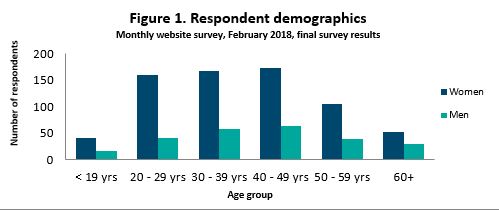
As for previous surveys, the demographic profile of survey respondents remains consistent with our experience of the groups of people that are accessing the Relationships Australia website.
Men were more likely than women to estimate higher rates when asked about young people’s exposure to pornography (figure 2). Just under 80 per cent of men and 75 per cent of women estimated that they thought more than 60 per cent of young people aged between 11 and 16 years had been exposed to pornography.
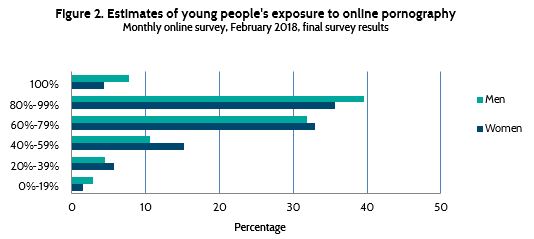
A substantial proportion of survey respondents estimated that young people were harmed if they were exposed to online pornography on at least one occasion (figure 3). Women (45%) were more likely than men (27%) to report a single exposure to online pornography harms young people, while men (22%) were more likely than women (11%) to report young people are only harmed if they see online pornography frequently.
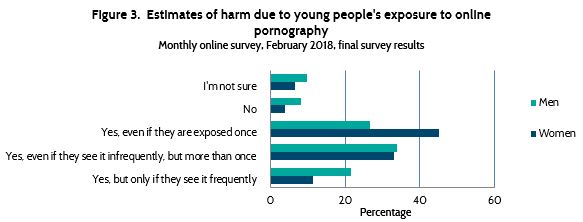
More than 60 per cent of women and 50 per cent of men reported that online exposure to pornography causes young people multiple types of harm (figure 4). Men (29%) were more likely than women (20%) to report that young people’s online exposure to pornography leads to unrealistic expectations of sex, while men and women were equally likely (8%) to report young people’s exposure to online pornography increases risky behaviour such as sex at younger ages and unprotected sex.
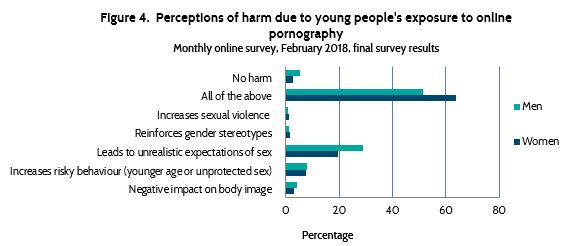
Survey respondents were asked to indicate who they consider is responsible for protecting young adolescents (11-16 years old) against the potential harm of online pornography. More than 80 per cent of women and 65 per cent of men reported that everyone has responsibility, including parents, extended family, schools, and state and commonwealth government. Seventeen per cent of women and 29 per cent of men thought parents were responsible for protecting young people.
Around half of survey respondents indicated they would seek help from a range of sources if they were worried about a young person’s exposure to online pornography (figure 5). The most commonly cited places men and women would seek help included the internet and local support services. Very few men (12%) and women (6%) reported they would only seek help from family or friends.
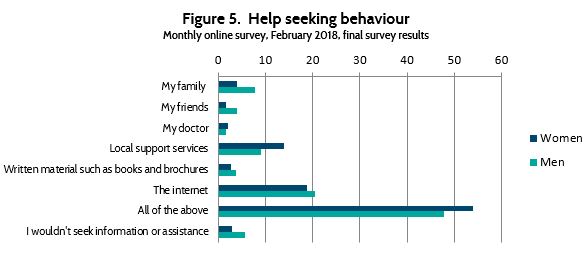
References
Australian Institute of Family Studies (2016). Children and young people’s exposure to pornography available at https://aifs.gov.au/cfca/2016/05/04/children-and-young-peoples-exposure-pornography
English, B. (2005). The secret life of boys: Pornography is a mouse click away, and kids are being exposed to it in ever-increasing numbers. Cited in the American Psychological Association. (2007). Report of the APA Task Force on the Sexualization of Girls. Washington, DC: Author.
Wosnitzer, R. J. and Bridges, A. (2007). Aggression and Sexual Behavior in Best-Selling Pornography: A Content Analysis Update. Paper presented at the annual meeting of the International Communication Association, San Francisco.
